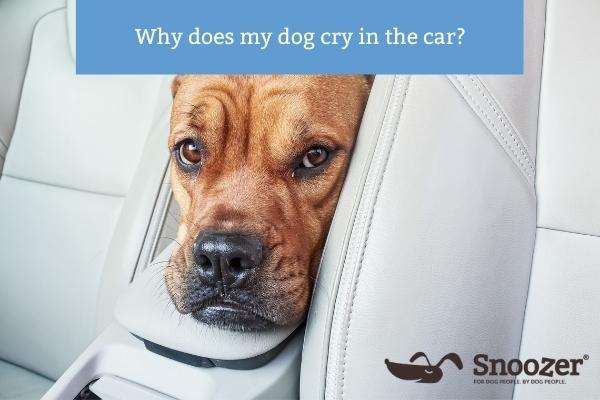Why does my dog whine in the car? The most common reasons dogs whine in the car are anxiety, car sickness, excitement, or needing to go to the bathroom. This article will help you figure out which one it is and how to help your furry friend enjoy car rides!

Image Source: snoozerpetproducts.com
Deciphering Your Dog’s Car Whining
Dog whining in the car can be a stressful experience for both you and your pet. To effectively address the problem, it’s essential to figure out why your dog is whining. Several factors can contribute to this behavior, and pinpointing the root cause is the first step towards finding the right solutions.
Anxiety: A Major Culprit
Dog whining car anxiety is a very common issue. The car environment can be overwhelming for some dogs. Here’s a breakdown of potential anxiety triggers:
- Fear of the Destination: Is the car always associated with a trip to the vet or groomer? Negative associations can trigger anticipatory anxiety and whining.
- Motion Sickness: Some dogs experience car sickness dogs, which leads to nausea and discomfort, causing them to whine.
- Confinement: Feeling trapped or restricted within the car can induce panic and anxiety.
- Novelty: For puppies especially, the car is an unfamiliar environment filled with strange noises and movements. This newness can cause puppy whining car ride.
- Past Trauma: Previous negative experiences in a car, such as a car accident or a stressful journey, can create lasting anxiety.
Car Sickness
Car sickness dogs should not be overlooked. It often manifests as whining, drooling, vomiting, and general discomfort. Here are some contributing factors:
- Inner Ear Imbalance: The inner ear plays a vital role in balance. The motion of the car can disrupt this balance, leading to nausea.
- Anxiety-Induced Nausea: Anxiety itself can trigger nausea, creating a vicious cycle of whining and discomfort.
- Age: Puppies are more prone to car sickness because their inner ear structures are not fully developed.
Excitement & Anticipation
Sometimes, reasons dog whines in vehicle might be due to positive excitement! If your dog knows the car leads to fun places like the park or a friend’s house, their whining could be a sign of anticipation.
- Excitement Whining: This type of whining is usually accompanied by tail wagging, panting, and an overall energetic demeanor.
Other Potential Causes
- Need to Eliminate: A simple reason could be that your dog needs to go to the bathroom.
- Boredom: Long car rides can lead to boredom, resulting in whining.
- Attention Seeking: Some dogs whine simply to get your attention.
Assessing Your Dog’s Behavior
Observe your dog’s behavior closely to determine the likely cause of their whining. Consider the following questions:
- When does the whining start? (Before you even get in the car? Once the car starts moving?)
- What else is your dog doing? (Panting, drooling, shaking, pacing, barking?)
- Where are you going? (Vet? Park? Home?)
- Has your dog experienced any car sickness symptoms (vomiting, diarrhea, lethargy) after car rides?
Table: Symptoms and Potential Causes
| Symptom | Possible Cause(s) |
|---|---|
| Whining + Panting | Anxiety, Car Sickness, Excitement |
| Whining + Drooling | Car Sickness, Anxiety |
| Whining + Shaking | Anxiety, Fear |
| Whining + Vomiting | Car Sickness |
| Whining + Tail Wagging | Excitement |
| Whining + Restlessness | Anxiety, Need to Eliminate, Boredom |
| Whining Alone | Attention Seeking, Mild Anxiety, Boredom |
Dog Car Anxiety Remedies: Solutions and Dog Car Travel Tips
Once you’ve identified the likely cause of your dog’s whining, you can start implementing strategies to alleviate their discomfort and promote a more positive car travel experience. These dog whining car solutions focus on reducing anxiety, preventing car sickness, and creating positive associations with car rides.
Desensitization & Counterconditioning
This approach gradually exposes your dog to the car and car rides in a controlled and positive manner.
- Step 1: Car Familiarization:
- Start by simply allowing your dog to spend time near the car without getting inside.
- Reward them with treats and praise for calm behavior.
- Step 2: Short Car Visits:
- Progress to having your dog sit inside the car for short periods, gradually increasing the duration.
- Continue to offer treats and praise.
- Start with the car turned off, then progress to having the car running but stationary.
- Step 3: Short Drives:
- Begin with very short drives around the block, gradually increasing the distance and duration of the trips.
- Maintain a positive and reassuring demeanor.
- End each ride with a positive experience, such as a walk in the park.
- Counterconditioning:
- Pair the car with positive experiences.
- Give your dog their favorite toys or treats only during car rides. This helps them associate the car with good things.
Addressing Car Sickness
If car sickness dogs is the primary concern, consider these strategies:
- Medication: Consult with your veterinarian about anti-nausea medications specifically designed for dogs.
- Dietary Adjustments: Feed your dog a light meal a few hours before the car ride to prevent an empty stomach, which can worsen nausea. Avoid feeding them right before travel.
- Fresh Air: Ensure adequate ventilation by opening windows slightly or using the air conditioning.
- Comfortable Positioning: Allow your dog to lie down comfortably. A comfortable bed or blanket can help.
- Minimize Motion: Drive smoothly and avoid sudden acceleration, braking, or sharp turns.
Calming Dog In Car: Techniques
These techniques help reduce dog stress travel and promote a sense of calm:
- Safe and Secure: Use a properly sized crate or a dog car seat to keep your dog secure and prevent them from moving around excessively.
- Familiar Scents: Bring along a favorite blanket or toy that smells like home to provide comfort and familiarity.
- Calming Music: Play calming music specifically designed for dogs. Classical music or reggae has shown promising results.
- Pheromone Products: Use dog-appeasing pheromone (DAP) sprays or diffusers, which mimic a mother dog’s natural pheromones and can help reduce anxiety.
- Consider a Thundershirt: A Thundershirt applies gentle, constant pressure, which can have a calming dog in car effect similar to swaddling a baby.
- Natural Remedies: Some owners have found success with natural remedies such as ginger (for nausea) or chamomile (for calming). Consult with your veterinarian before administering any supplements.
Modifying the Car Environment
Making the car a more comfortable and inviting space can significantly reduce anxiety:
- Temperature Control: Ensure the car is at a comfortable temperature.
- Sun Glare: Use sunshades to reduce glare and prevent overheating.
- Visibility: Allow your dog to see out the window, as this can help reduce motion sickness. However, make sure they are safely restrained.
Training & Management
Consistent training can help manage your dog’s behavior in the car:
- “Quiet” Command: Teach your dog a “quiet” command to discourage excessive whining.
- Positive Reinforcement: Reward calm behavior with treats and praise.
- Ignore Whining: If the whining is attention-seeking, ignore it. Only give attention when your dog is quiet and calm.
Preventative Measures
Preventative measures can help reduce the likelihood of your dog developing car anxiety in the first place, especially for puppies.
- Early Exposure: Introduce your puppy to car rides at a young age, starting with short, positive experiences.
- Socialization: Expose your puppy to a variety of environments and experiences to build their confidence and reduce anxiety.
- Positive Associations: Always associate car rides with positive experiences, such as trips to the park or playdates.
When to Seek Professional Help
If your dog’s dog whining car anxiety is severe or doesn’t improve with these strategies, consult with a veterinarian or a certified dog behaviorist. They can help identify underlying medical or behavioral issues and recommend appropriate treatment options, such as medication or behavior modification therapy.
Conclusion
Dog behavior in car, specifically whining, can be frustrating, but by figuring out the cause and using these strategies, you can greatly reduce your dog’s anxiety and make car travel a much more enjoyable experience for everyone. Remember to be patient, consistent, and positive, and celebrate even small improvements in your dog’s behavior.
Frequently Asked Questions (FAQ)
Q: What is the best way to stop a dog from whining in the car?
A: The best way to stop a dog from whining depends on the reason for the whining. Try desensitization, addressing car sickness, creating a calming environment, and positive reinforcement training. If the problem is severe, consult your vet.
Q: Can I give my dog Benadryl for car anxiety?
A: While Benadryl (diphenhydramine) can have a mild sedative effect in some dogs, it’s not a reliable treatment for car anxiety and might not work for all dogs. Always consult with your veterinarian before giving your dog any medication, including over-the-counter drugs like Benadryl. Your vet can advise on the appropriate dosage and potential side effects.
Q: Is it cruel to crate my dog in the car?
A: No, it’s not cruel to crate your dog in the car if the crate is properly sized, well-ventilated, and secured. Crating can actually provide a sense of security and reduce anxiety for some dogs, as it gives them a safe and familiar space.
Q: How long should I wait before taking my puppy on a car ride?
A: You can start taking your puppy on short car rides as soon as they are cleared by your veterinarian for travel, usually after their initial vaccinations. Start with very short trips and gradually increase the duration as your puppy becomes more comfortable.
Q: What are some signs of car sickness in dogs?
A: Signs of car sickness in dogs include whining, excessive drooling, panting, lip licking, restlessness, vomiting, diarrhea, and lethargy.
